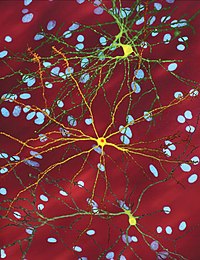
Photo from wikipedia
Huntington’s disease is a genetic disease caused by expanded CAG repeats on exon 1 of the huntingtin gene located on chromosome 4. Compelling evidence implicates impaired mitochondrial energetics, altered mitochondrial… Click to show full abstract
Huntington’s disease is a genetic disease caused by expanded CAG repeats on exon 1 of the huntingtin gene located on chromosome 4. Compelling evidence implicates impaired mitochondrial energetics, altered mitochondrial biogenesis and quality control, disturbed mitochondrial trafficking, oxidative stress and mitochondrial calcium dyshomeostasis in the pathogenesis of the disorder. Unfortunately, conventional mitochondrial-targeted molecules, such as cysteamine, creatine, coenzyme Q10, or triheptanoin, yielded negative or inconclusive results. However, future therapeutic strategies, aiming to restore mitochondrial biogenesis, improving the fission/fusion balance, and improving mitochondrial trafficking, could prove useful tools in improving the phenotype of Huntington’s disease and, used in combination with genome-editing methods, could lead to a cure for the disease.
Journal Title: Neural Regeneration Research
Year Published: 2022
Link to full text (if available)
Share on Social Media: Sign Up to like & get
recommendations!